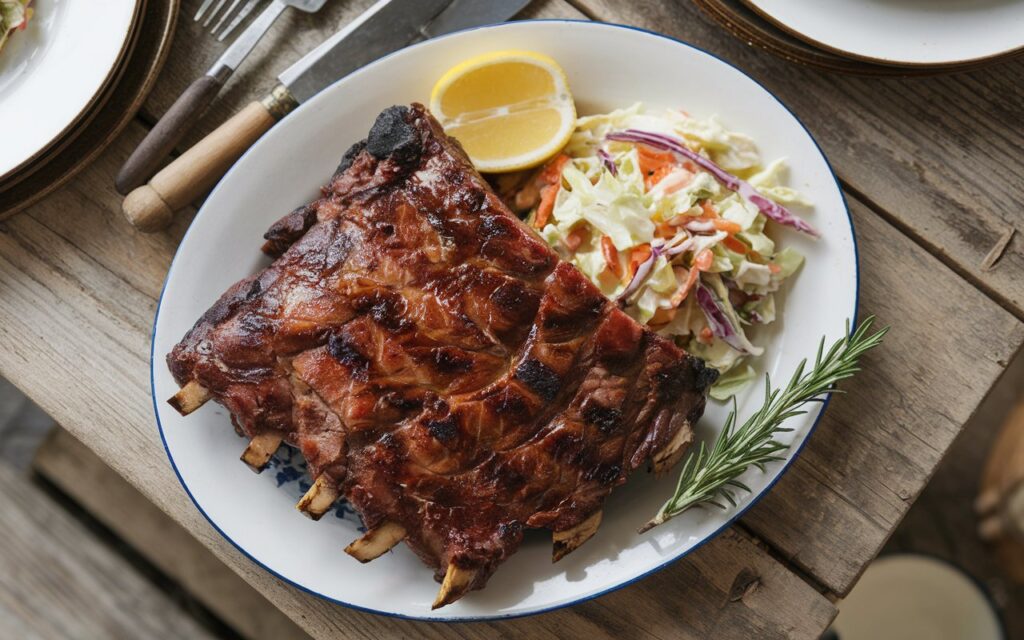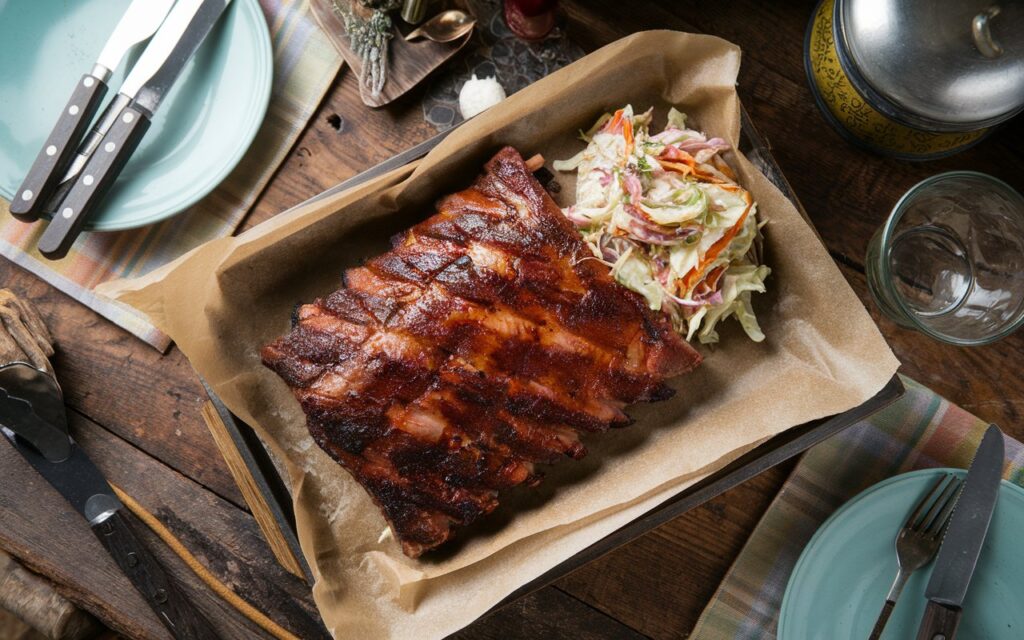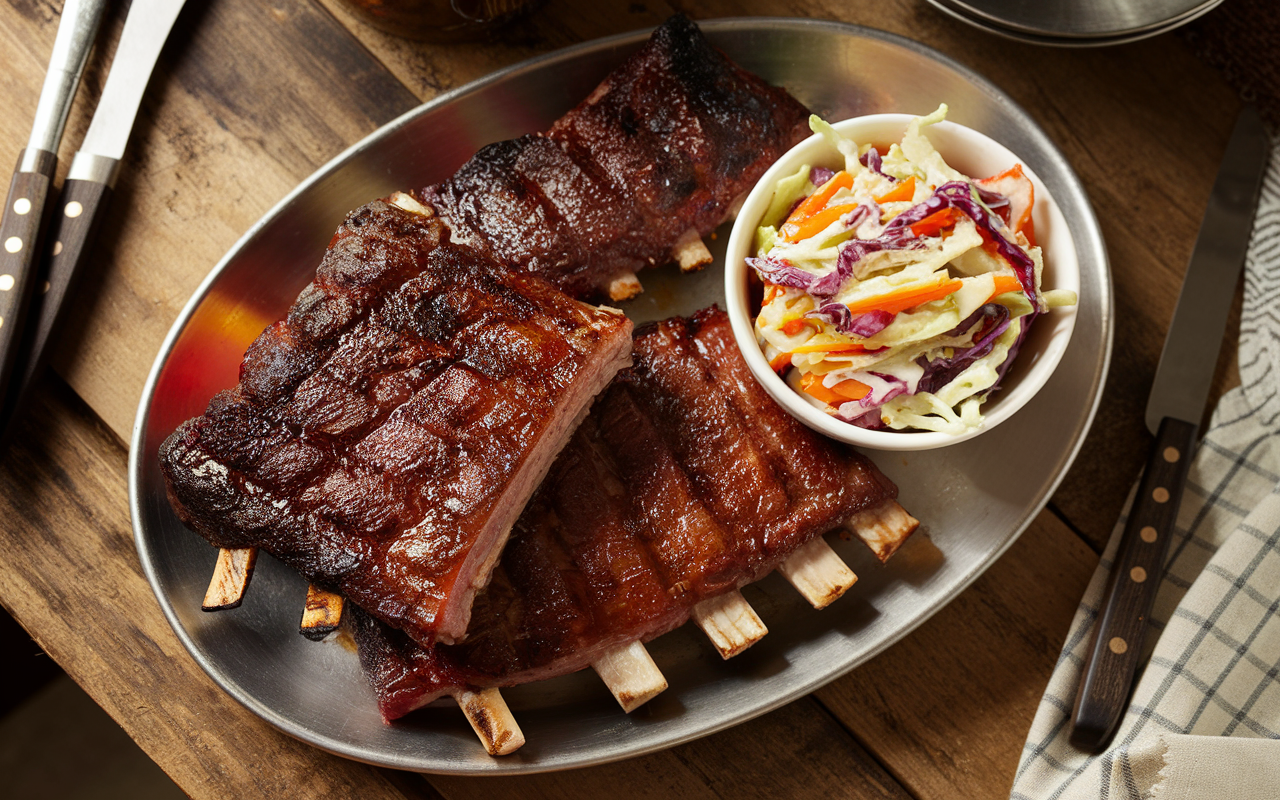When it comes to tender, flavorful dishes, few meals compare to a perfectly cooked boneless beef ribs recipe. These ribs are a versatile choice for family dinners, barbecues, or weekend indulgences. Whether slow-cooked, grilled, or baked, they deliver a melt-in-your-mouth experience that’s sure to please.
In this guide, you’ll not only discover how to prepare the best boneless beef ribs recipe, but also learn essential cooking techniques. Additionally, we’ll cover seasoning tips and FAQs to ensure your ribs turn out perfectly every time. For example, if you’re looking for additional guidance on slow cooking, be sure to check out this guide to slow-cooker meats. Altogether, this guide is designed to help you master the art of making irresistible boneless beef ribs recipe
Why Choose Boneless Beef Ribs?
boneless beef ribs recipe are an excellent alternative to traditional bone-in ribs. They offer:
- Ease of Cooking: No bones mean more meat and simpler preparation.
- Versatility: Perfect for a variety of cooking methods, including grilling, braising, and baking.
- Flavor and Texture: With proper cooking, they turn tender and flavorful, soaking up marinades and sauces effortlessly.
For additional insight into choosing the best cuts of beef, refer to this comprehensive beef cut guide.
How to Cook Boneless Beef Ribs: Step-by-Step
1. Selecting the Best Ribs
When shopping for boneless beef ribs, look for:
- Marbling: Fat marbling ensures tenderness and rich flavor.
- Freshness: Bright red meat with no off smells.
- Thickness: Evenly cut ribs for uniform cooking.
2. Preparation
Preparing boneless beef ribs correctly is key to a successful dish.
Ingredients:
- 2 lbs boneless beef ribs
- 2 tsp kosher salt
- 1 tsp black pepper
- 1 tbsp olive oil
- 1 cup barbecue sauce (optional)
- 1 tbsp garlic powder
- 1 tsp smoked paprika
Steps:
- Trim the Ribs: Remove excess fat for a cleaner presentation and less grease.
- Season Generously: Rub the ribs with salt, pepper, garlic powder, and smoked paprika.
- Marinate (Optional): For extra flavor, marinate in your favorite sauce for 2–4 hours.
3. Cooking Methods
Oven-Baked Boneless Beef Ribs
This method locks in flavor and creates a fall-apart texture.
- Preheat the oven to 325°F (163°C).
- Place the ribs in a baking dish and cover with foil.
- Bake for 2.5–3 hours, basting occasionally with barbecue sauce.
- Broil for 5 minutes at the end to caramelize the sauce.
Grilled Boneless Beef Ribs
For smoky, charred ribs, grilling is the way to go.
- Preheat the grill to medium-high heat.
- Sear the ribs for 3–4 minutes per side.
- Lower the heat, brush with sauce, and cook indirectly for 20–25 minutes.
Slow-Cooked Boneless Beef Ribs
Slow cooking ensures maximum tenderness.
- Place seasoned ribs in a slow cooker.
- Add 1 cup of beef broth and ½ cup of barbecue sauce.
- Cook on low for 6–8 hours or high for 4–5 hours.
Tips for Perfect Boneless Beef Ribs
- Avoid Overcooking: Monitor cooking times to prevent dryness.
- Use a Meat Thermometer: Aim for an internal temperature of 200°F (93°C) for tender results.
- Rest the Meat: Let the ribs rest for 10 minutes after cooking to redistribute juices.
Boneless Beef Ribs vs. Bone-In Ribs
Understanding the differences between boneless beef ribs and bone-in ribs can help you decide which cut is best for your recipe. Both options offer unique benefits, and the choice often depends on personal preference, cooking methods, and the desired flavor profile.
Flavor
- Bone-In Ribs: Bones add depth of flavor during the cooking process, as the marrow enhances the richness of the meat. This is why bone-in ribs are often preferred for slow cooking or smoking.
- Boneless Beef Ribs: While they may lack the added flavor from the bones, boneless ribs absorb marinades and seasonings more effectively, making them ideal for recipes that rely on bold sauces.
Ease of Cooking
- Bone-In Ribs: Cooking bone-in ribs requires more time and attention. The meat needs to be cooked thoroughly to loosen from the bone and achieve the desired tenderness.
- Boneless Beef Ribs: These are easier to cook and require less preparation. They can be grilled, baked, or slow-cooked without the challenge of working around the bones.
Serving and Eating
- Bone-In Ribs: Great for hands-on eating experiences, such as barbecues or casual gatherings. However, the bones can make serving portions more challenging to measure.
- Boneless Beef Ribs: Perfect for formal meals or recipes where precise portions are required. They’re easier to cut, serve, and eat with utensils.
Cooking Techniques
- Bone-In Ribs: Best suited for low-and-slow cooking methods, such as smoking or braising, which allow the connective tissue around the bone to break down, resulting in tender meat.
- Boneless Beef Ribs: Versatile and adaptable to various cooking styles. They can be grilled for a quick dinner, baked for a rich and saucy dish, or slow-cooked for a melt-in-your-mouth texture.
Cost and Availability
- Bone-In Ribs: Typically more affordable than boneless cuts because they require less processing. They’re widely available at butcher shops and grocery stores.
- Boneless Beef Ribs: Slightly more expensive due to the extra butchering required to remove the bones. However, their convenience often justifies the price.
Nutritional Differences
- Bone-In Ribs: Often contain slightly more fat and collagen, contributing to their rich flavor and texture.
- Boneless Beef Ribs: Tend to have a leaner profile, making them a healthier option depending on the preparation.
Which Should You Choose?
- For Rich Flavor: Opt for bone-in ribs to enjoy the natural enhancement from the bone marrow.
- For Convenience: Choose boneless beef ribs for easier preparation, faster cooking, and no hassle when eating.
- For Special Occasions: Bone-in ribs make an impression with their rustic, hearty appeal.
- For Everyday Meals: Boneless beef ribs are versatile and practical for weeknight dinners or meal prep.
Both boneless beef ribs and bone-in ribs are excellent choices for delicious meals. Your decision ultimately depends on your cooking style, occasion, and flavor preferences. Whether you’re braising bone-in ribs for a smoky barbecue or grilling boneless ribs for a quick family dinner, you’re sure to create a satisfying dish.
How to Make Boneless Beef Ribs for Special Diets
Boneless beef ribs can be tailored to meet various dietary needs without sacrificing flavor. Whether you’re following a keto, gluten-free, paleo, or low-calorie plan, these adjustments ensure your ribs fit seamlessly into your lifestyle.

1. Keto-Friendly Boneless Beef Ribs
The keto diet emphasizes low-carb, high-fat meals, making boneless beef ribs a fantastic option.
Tips for Keto Ribs:
- Use a sugar-free barbecue sauce or make your own using tomato paste, apple cider vinegar, and erythritol.
- Replace sweet marinades with a blend of olive oil, garlic, paprika, and mustard.
- Pair ribs with keto sides like roasted cauliflower, sautéed spinach, or zucchini fries.
Keto Recipe Idea:
- Season ribs with a dry rub of smoked paprika, chili powder, and garlic powder.
- Slow cook for 6 hours with beef broth and a splash of tamari for added umami.
2. Gluten-Free Boneless Beef Ribs
For those avoiding gluten, it’s essential to ensure that all sauces, marinades, and ingredients are gluten-free.
Tips for Gluten-Free Ribs:
- Replace regular soy sauce with tamari or coconut aminos.
- Use gluten-free Worcestershire sauce in your marinade.
- Avoid store-bought spice blends with hidden gluten; make your own with garlic powder, onion powder, and smoked paprika.
Gluten-Free Recipe Idea:
- Marinate ribs in tamari, garlic, ginger, and sesame oil.
- Grill or bake the ribs, basting with gluten-free barbecue sauce.
3. Paleo Boneless Beef Ribs
The paleo diet focuses on whole, unprocessed foods. Boneless beef ribs can easily align with these guidelines.
Tips for Paleo Ribs:
- Sweeten marinades naturally with honey or maple syrup instead of sugar.
- Avoid processed sauces; use homemade blends of tomato paste, vinegar, and spices.
- Stick to natural oils like olive oil or avocado oil.
Paleo Recipe Idea:
- Rub ribs with a mix of cumin, smoked paprika, and garlic powder.
- Slow cook in a sauce made from tomato puree, apple cider vinegar, and a touch of honey.
4. Low-Calorie Boneless Beef Ribs
If you’re watching your calorie intake, boneless beef ribs can still fit into your meal plan with a few modifications.
Tips for Low-Calorie Ribs:
- Choose leaner cuts of boneless beef ribs with less marbling.
- Limit heavy sauces and instead use spice rubs for flavor.
- Bake or grill instead of frying to reduce added fats.
Low-Calorie Recipe Idea:
- Use a dry rub of chili powder, garlic, and black pepper.
- Grill ribs for a smoky flavor without additional fats.
- Serve with steamed vegetables or a simple green salad.
5. Dairy-Free Boneless Beef Ribs
For individuals avoiding dairy, most traditional recipes for boneless beef ribs are naturally dairy-free. Ensure that all condiments and sides also align with this requirement.
Tips for Dairy-Free Ribs:
- Check store-bought sauces for hidden dairy ingredients.
- Opt for homemade marinades with olive oil, vinegar, and herbs.
Dairy-Free Recipe Idea:
- Marinate ribs in olive oil, lemon juice, garlic, and rosemary.
- Bake or grill and serve with dairy-free mashed potatoes made with almond milk.
6. Low-Sodium Boneless Beef Ribs
If you’re following a low-sodium diet, these simple swaps can reduce salt content while preserving flavor.
Tips for Low-Sodium Ribs:
- Use low-sodium soy sauce or coconut aminos.
- Season with fresh herbs like rosemary, thyme, and parsley instead of salt.
- Avoid store-bought sauces, which are often high in sodium.
Low-Sodium Recipe Idea:
- Create a marinade using lemon juice, garlic, smoked paprika, and a pinch of black pepper.
- Slow cook with unsalted beef broth for tender, flavorful ribs.
Serving Ideas for Boneless Beef Ribs
A perfectly cooked boneless beef ribs recipe is versatile and pairs wonderfully with a variety of side dishes and creative presentations. Here are some serving ideas to inspire you:

1. Classic Comfort Meal
Pair your boneless beef ribs with traditional comfort foods for a hearty and satisfying meal:
- Mashed Potatoes: Creamy and buttery potatoes complement the rich, savory flavors of the ribs.
- Cornbread: Sweet, crumbly cornbread is a classic barbecue side.
- Green Beans: Steamed or sautéed green beans add freshness to balance the richness.
2. Southern-Style Feast
Create a Southern-inspired spread by serving boneless beef ribs with:
- Coleslaw: Crisp and tangy slaw provides a refreshing contrast to the smoky ribs.
- Macaroni and Cheese: Creamy, cheesy pasta pairs perfectly with barbecue sauce.
- Baked Beans: Sweet and savory beans round out the meal.
3. Light and Fresh Options
For a lighter, more refreshing meal, pair the ribs with these options:
- Grilled Vegetables: Zucchini, bell peppers, and asparagus add a smoky and healthy touch.
- Arugula Salad: A peppery salad with a lemon vinaigrette enhances the meal’s flavors.
- Cauliflower Rice: A low-carb alternative to traditional sides.
4. International Fusion
Experiment with global flavors by pairing your ribs with international sides:
- Mexican-Inspired: Serve ribs with corn tortillas, pico de gallo, and guacamole for a taco-inspired dish.
- Asian-Style: Add jasmine rice, steamed bok choy, and a drizzle of soy-ginger glaze.
- Mediterranean Touch: Pair with roasted vegetables, hummus, and pita bread.
5. Rib Bowl Creations
Transform your boneless beef ribs into a trendy bowl meal:
- 5. Rib Bowl Creations
- Transform your boneless beef ribs into trendy and flavorful bowl meals. These options are not only delicious but also easy to customize based on your preferences.
- Barbecue Bowl: To create a hearty meal, layer shredded ribs with coleslaw, baked beans, and cornbread croutons in a bowl. This combination ensures a balance of textures and flavors that will satisfy every bite.
- Loaded Potato Bowl: For a comforting option, serve ribs over a baked potato topped with sour cream, cheese, and chives. Additionally, you can sprinkle crispy bacon for an extra burst of flavor.
- Rice Bowl: If you prefer an Asian-inspired twist, combine ribs with white rice, sautéed veggies, and a drizzle of teriyaki sauce. Moreover, adding sesame seeds or green onions can enhance the dish’s appeal and texture.
6. Sandwiches and Sliders
Use boneless beef ribs as the star ingredient in sandwiches:
- Pulled Rib Sandwich: Shred the ribs, toss with barbecue sauce, and serve on a toasted bun with pickles.
- Rib Sliders: Perfect for appetizers or parties, serve ribs in small buns with coleslaw.
- Flatbread Wrap: Wrap ribs, lettuce, and sauce in a warm flatbread for a handheld option.
7. Leftover Makeovers
Repurpose leftover ribs into new and exciting dishes:
- Tacos: To create flavorful tacos, shred the ribs and, afterward, top them with salsa, avocado, and lime juice in a soft tortilla.Pizza Topping: Additionally, enhance your pizza by adding shredded ribs and barbecue sauce to a crust, creating a smoky flavor twist.Stir-Fry: For a quick and delicious dinner, toss rib meat with stir-fried veggies and soy sauce, ensuring a savory and satisfying meal.
8. Elegant Plating for Special Occasions
Dress up your boneless beef ribs for a formal dinner:
- Polenta Base: Serve ribs over creamy polenta and garnish with fresh herbs.
- Root Vegetable Puree: Plate ribs on a bed of carrot or parsnip puree for a sophisticated presentation.
- Microgreens Garnish: Add a touch of elegance with microgreens or edible flowers.
By choosing the right sides and presentation, you can elevate your boneless beef ribs recipe from a simple dish to a show-stopping meal. Whether you prefer traditional pairings or creative twists, these ideas ensure your ribs will always shine as the centerpiece of your table.
Frequently Asked Questions (FAQs)
What is the preferred cooking method for boneless short ribs?
Slow cooking or oven-baking are generally the most preferred methods, as they result in tender and juicy ribs. In particular, these techniques allow the meat to break down slowly, ensuring it remains flavorful and soft. Consequently, the texture is much more enjoyable compared to faster cooking methods.
Why are my boneless beef ribs tough?
Tough ribs frequently result from undercooking. Therefore, it is essential to cook them low and slow to achieve the best texture. Additionally, using a marinade can help tenderize the meat further, especially if you are working with a leaner cut. Altogether, taking the time to cook them properly makes all the difference.
Can you cook boneless beef ribs like a steak?
Yes, you can cook boneless beef ribs like a steak. However, they require high heat for a quick sear. Moreover, it is important to allow longer resting time to avoid toughness. As a result, this method can work well for thinly sliced ribs or when time is limited.
Are boneless beef ribs the same as short ribs?
Not exactly. While both cuts are flavorful, boneless beef ribs come from the chuck, whereas short ribs are taken from the plate section. Additionally, short ribs typically contain a bone, which enhances their flavor during cooking. Nevertheless, boneless beef ribs are equally versatile and easier to handle.

